|
|
| RESEARCH ACTIVITIES |
 |
| Rare-earth Doped Nanomaterials |
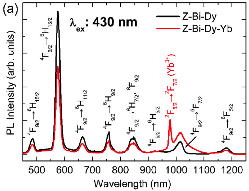 |
153. Zhenhua Bai, Minoru Fujii, Takashi Hasegawa, Kenji Imakita,Minoru Mizuhata and Shinji Hayashi,
Efficient ultraviolet-blue to near-infrared downconversion in Bi-Dy-Yb doped zeolites
Journal of Physics D: Applied Physics, Vol. 44, pp. 455301 1-5 (2011). |
| Ultraviolet-blue to near-infrared (NIR) downconversion is investigated
for the Dy3+–Yb3+ couple in zeolites by steady-state and time-resolved
photoluminescence (PL) spectra, and PL excitation spectra. Upon excitation
of the 4F9/2 level of Dy3+, NIR quantum cutting could occur through a two-step
energy transfer from one Dy3+ ion to two neighbouring Yb3+ ions via an
intermediate level. The energy transfer efficiency from the 4F9/2 level
is estimated to be 42%, and the intrinsic PL quantum efficiency of Yb3+
emission reaches 54%. The findings may have potential application in enhancing
the energy efficiency of silicon-based solar cells. |
|
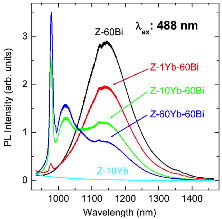 |
145. Zhenhua Bai, Hong-Tao Sun, Minoru Fujii, Yuji Miwa,Takashi Hasegawa, Minoru
Mizuhata and Shinji Hayashi,
Bismuth-sensitized Efficient Near-infrared
Luminescence from Ytterbium in Zeolites
Journal of Physics D:
Applied Physics, Vol. 44, 155101, pp. 1-5 (2011). |
| Yb–Bi co-doped zeolites are prepared by a method consisting of a simple
ion-exchange process and subsequent high-temperature annealing. We observe
two strong near-infrared (NIR) emission bands overlapping in the range
930–1480 nm, corresponding to the electronic transitions of bismuth-related
active centres (BiRAC) and Yb3+ ions, respectively. In the obtained products,
the excitation wavelength of Yb3+ is extended to the range 420–850 nm,
and the lifetime reaches 665 µs. In the zeolite matrix, Bi ions exist as
BiRAC and Bi compound agglomerates. The former act as a sensitizer of Yb3+
ions, and the latter act as a blockage to seal the pores of zeolites, which
enables Yb3+ ions to show efficient NIR emission even if the zeolites contain
a large amount of coordinated water. The excellent optical and structural
properties make these NIR-emitting nanoparticles promising in applications
as biological probes. |
|
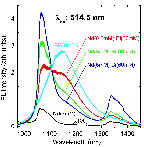 |
144. Zhenhua Bai, Minoru Fujii, Yuki Mori, Yuji Miwa, Minoru Mizuhata, Hong-Tao
Sun, and Shinji Hayashi,
Efficient Near-infrared Emission from
Neodymium by Broadband Sensitization of Bismuth in Zeolites
Optics Letters, Vol. 36, No. 6,
pp. 1017-1019 (2011) . |
| Nd-Bi codoped zeolites were prepared by an ion-exchange process, and the
optical properties were investigated by photoluminescence (PL) and PL excitation
spectra, and decay time measurements. The results show that the NIR emission
of Nd3+ ions is significantly enhanced by the introduction of bismuth in
codoped samples, and the lifetime reaches 246 μs. It is also observed that
NIR-active Bi acts as a sensitizer of Nd3+ ions. The energy transfer efficiency
is also estimated. The peculiar optical properties make Nd-Bi codoped zeolites
promising for potential application in biological probes. |
|
| |
131. Zhenhua Bai, Hong-Tao Sun, Takashi Hasegawa, Minoru Fujii, Fumiaki Shimaoka,
Yuji Miwa, Minoru Mizuhata, and Shinji Hayashi,
Efficient near infrared luminescence and energy transfer in erbium/bismuth co-doped zeolites
Optics Letters, Vol. 35, Issue 11, pp. 1926 - 1928 (2010) . |
| We have shown that tunable and highly efficient broadband near-IR (NIR)
luminescence can be realized in erbium/bismuth codoped zeolites. The emission
covers the ranges of 930–1450nm and 1450–1630nm. The intensity ratio of
the two bands can be tuned by adjusting the concentration of erbium and
the excitation wavelength. Steady-state and time-resolved photoluminescence
(PL), and PL excitation measurements indicate that two kinds of emitters
coexist in the pores of zeolites, and that NIR active bismuth simultaneously
acts as a sensitizer of erbium. The present results demonstrate an important
rational strategy for the design of a tunable NIR-emitting zeolite-based
nanosystem. |
|
|
126. Hong-Tao Sun, Minoru Fujii, Noriko Nitta, Fumiaki Shimaoka, Minoru Mizuhata, Shinji Hayashi, Hidehiro Yasuda, and Shigehito Deki,
"Controlled Synthesis and Luminescent Properties of Erbium Silicate Nanostructures,”
Journal of Nanoscience and Nanotechnology, Vol. 9, No. 11, pp.6277–6282 (2009)
|
| Erbium silicate (Er2SiO5 and Er4Si3O12) nanostructures were successfully
synthesized by a facile molten-salt approach in the presence of NaCl and
surfactant. The synthesized products were structurally and morphologically
characterized by X-ray diffraction (XRD), scanning electron microscopy
(SEM), transmission electron microscopy (TEM), and high-resolution transmission
electron microscopy (HRTEM), whereas the luminescent properties were characterized
by temperature-dependent luminescence measurements. The results revealed
that the composition, crystalline phase, and yield of the final products
can be readily controlled by choosing suitable surfactant and tailoring
the molar ratio of reactants used for the reactions. Moreover, the single-crystalline
nature of Er2SiO5 and of Er4Si3O12 nanostructures results in sharp photoluminescence
(PL) of Er3+, and both nanostructures are immunized from temperature quenching
of PL. We suggest that the nanostructures developed in the present work
are promising building blocks for Si-based optoelectronics nanodevices. |
|
|
117. Hong-Tao Sun, Takashi Hasegawa, Minoru Fujii, Fumiaki Shimaoka,
Zhenhua Bai, Minoru Mizuhata, Shinji Hayashi, and Shigehiko Deki,
"Highly-Efficient and Air-stable Near Infrared Emission in Erbium/Bismuth Codoped Zeorites,”
Applied Physics Letters, Vol. 94, 141106, pp. 1-3 (2009). |
| We have shown that highly efficient and air-stable 1531 nm emission can
be realized in erbium/bismuth codoped zeolites. The luminescence lifetime
of Er3+ at 1531 nm can reach up to 4.2 ms. Bismuth compounds formed by
high temperature annealing can act as blockages of selectively closing
down the “in-out windows” of water molecules, i.e., Er3+ ions are sealed
in a low-vibrational environment by bismuth agglomerates even when the
samples contain a large amount of water. This finding may pave the way
for the applications of active ions doped porous materials in infrared
photonics. |
|
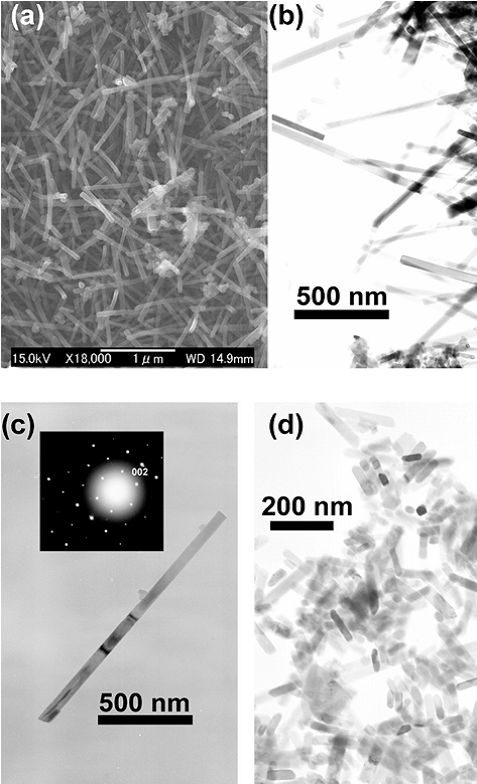 |
112. Hong-Tao Sun, Fumiaki Shimaoka, Minoru Fujii,
Noriko Nitta, Minoru Mizuhata, Hidehiro Yasuda, Shigehito Deki, and Shinji Hayashi,
"One-Step Synthesis and Near-Infrared Luminescent Properties of Er3+ and Ni2+ Doped Single-Crystalline Al18B4O33 Nanorods,”
Nanotechnology, Vol. 20, 035604, pp. 1-5, December (2008). |
| Er3+ and Ni2+ doped single-crystalline Al18B4O33 nanorods were synthesized
by a facile one-step toxic-free combustion method. The products were characterized
by x-ray diffraction, transmission electron microscopy, selected area electron
diffraction, and integrated and time-resolved photoluminescence (PL) measurements.
The phase purity, morphology, and PL properties of Er3+ and Ni2+ doped
Al18B4O33 nanorods can be readily controlled by tailoring the annealing
temperature. The mechanism for the formation of Al18B4O33 nanorods with
different aspect ratio is discussed. Er3+ doped Al18B4O33 nanorods show
strong PL centered at 1531 nm, while Ni2+ doped products show superwide
PL with a full width at half maximum of up to 250 nm. These aluminum borate
nanostructures are promising building blocks for optoelectronics nanodevices. |
|
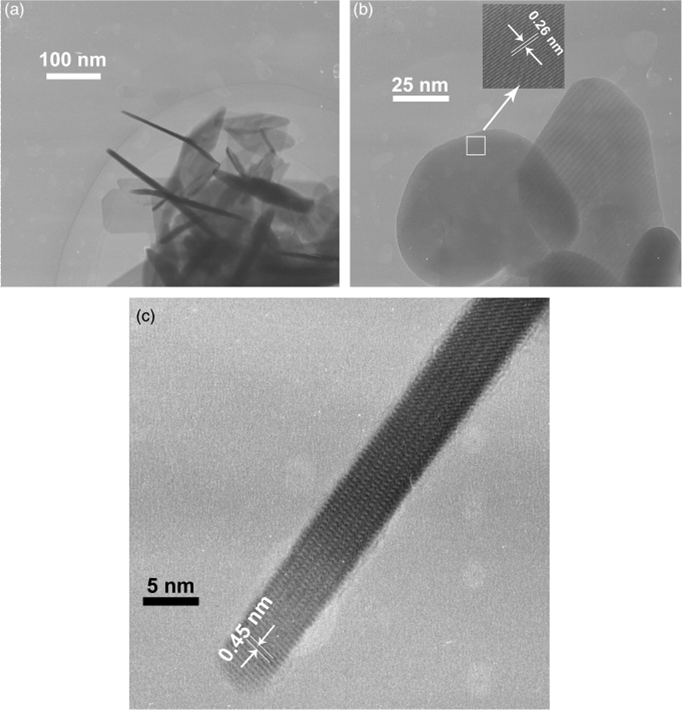 |
111. Hong-Tao Sun, Minoru Fujii, Noriko Nitta, Fumiaki
Shimaoka, Minoru Mizuhata, Hidehiro Yasuda, Shigehito Deki, and Shinji Hayashi,
"Large-Scale Controllable Synthesis and Characterization of Ytterbium Silicate Nanostructures,”
Journal of the Americal Ceramic Society, Vol. 91, No. 12, pp. 4158-4161 (2008). |
| Large-scale synthesis of ytterbium silicate (Yb2SiO5) nanoparticles and nanorods has been realized by a facile molten-salt approach. The synthesized products were structurally and morphologically characterized by X-ray diffraction, transmission electron microscopy (TEM), and high-resolution TEM. Our results revealed that the morphologies of Yb2SiO5 products can be readily controlled by a simple variation of the reactants used for the molten-salt reaction. Single-crystalline Yb2SiO5 nanorods with a high yield can be obtained using NP-7.5 as a surfactant. The formation mechanism of Yb2SiO5 nanostructures was also discussed. The method presented here for the synthesis of Yb2SiO5 nanostructures may pave the way for their application as environmental barrier coating materials. |
|
|
|
|
|
| |
| |
| |
| |
| |
| |
| |

|
|
|

